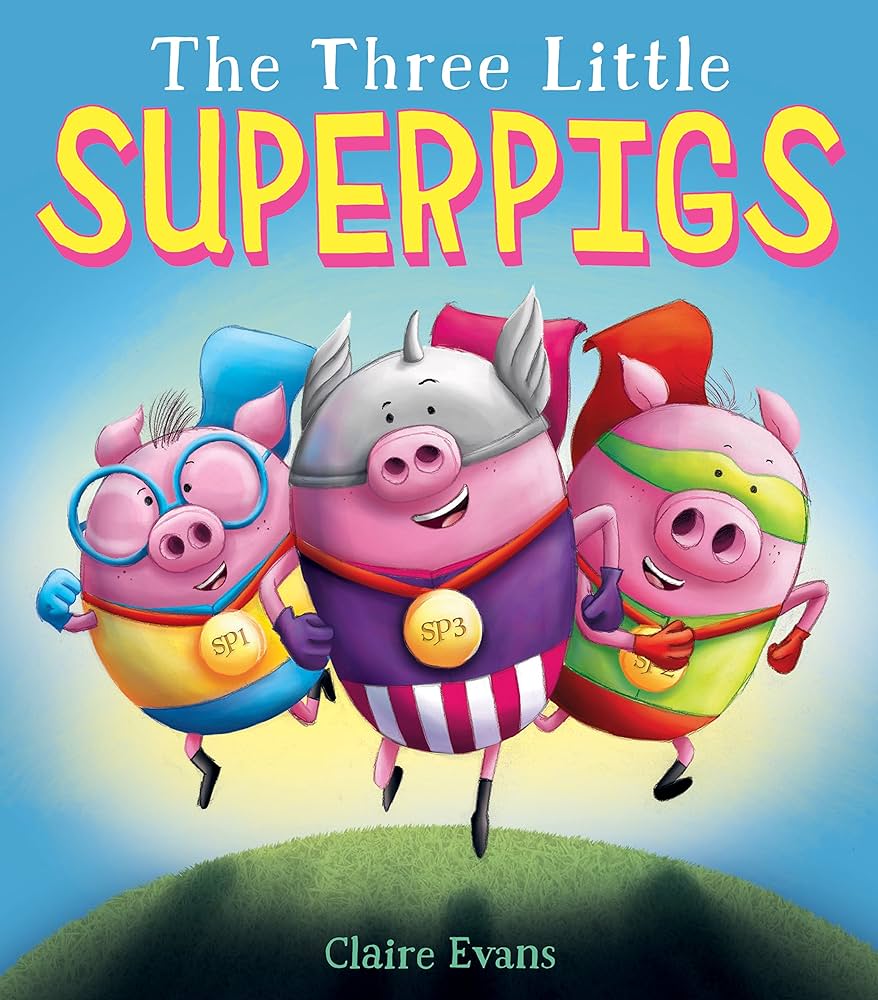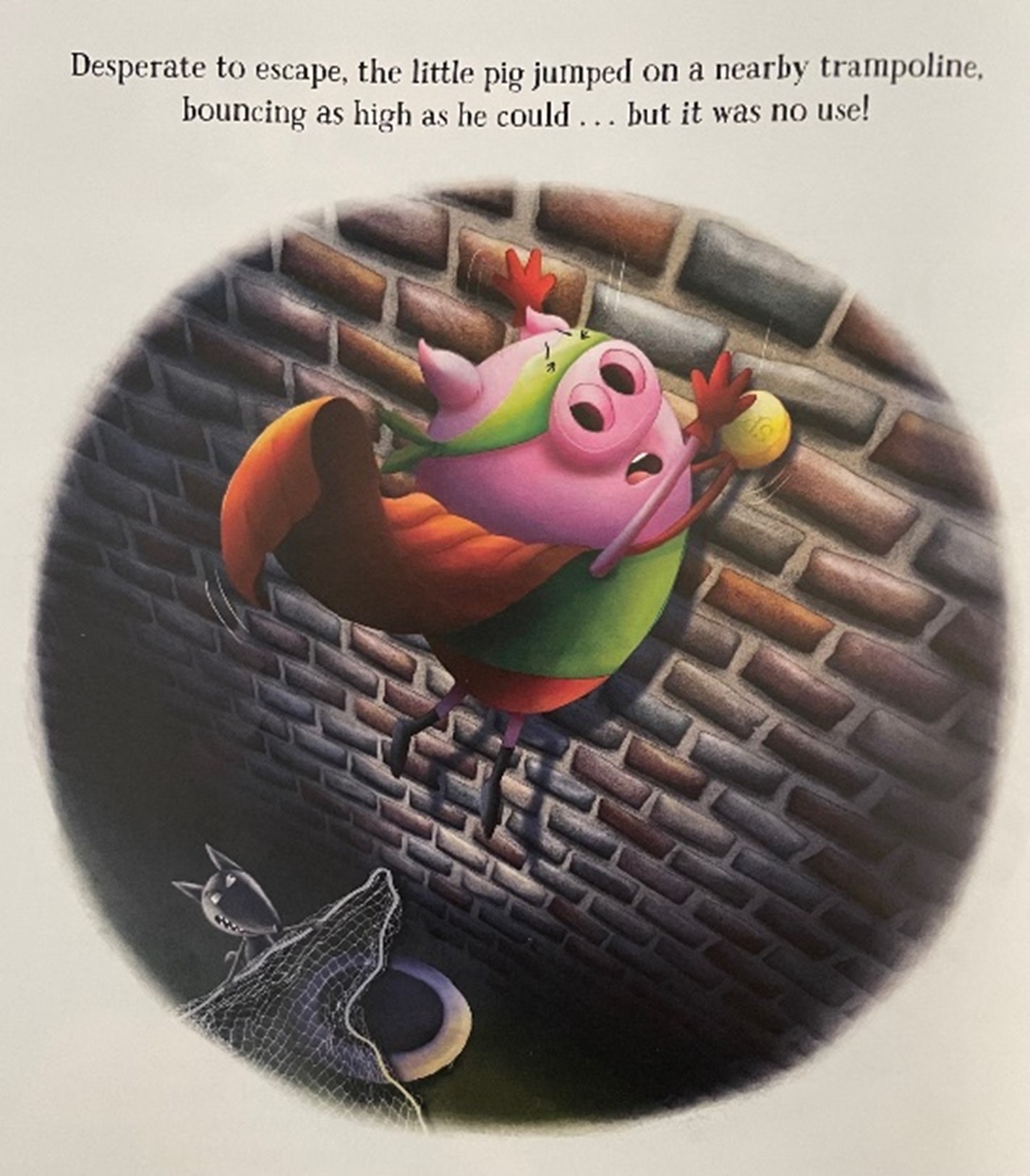This month's Book Nook topic is...
Waiting with
The Three Little Superpigs

It can be tempting to read a children’s book straight through without pausing – especially when it’s a suspenseful story and you’re both excited to see what happens next! But when you make an effort to pause and wait at the right times, you offer children much more than a fun story to listen to – you give them an opportunity to be active participants in the reading. You give them the time, space and encouragement to think about the story, form opinions, and share their thoughts with you. Waiting is an essential first step in turning book reading into a conversation, which supports children’s understanding of the story and prepares them for analyzing and talking about stories when they start school.
Let’s look at how we can incorporate waiting with The Three Little Superpigs!
The Book:
The Three Little Superpigs by Claire Evans
Why We Chose This Book
In this fun sequel to the original Three Little Pigs story, the Big Bad Wolf has hatched a new plan to capture the curly-tailed brothers! This book is a great choice for incorporating waiting because there are many intriguing elements for children to think and comment about if they’re given the time to do so – especially if they’re already familiar with the original story!
How to Wait
Waiting is a key part of the Hanen OWL strategy: Observe, Wait and Listen™. OWLing is the first step in turning book reading into a conversation, and it includes:
- Getting face-to face – Position yourself in a way that allows you to see each other’s faces while you read.
- Observing the child closely to find out what they’re interested in.
- Waiting at certain points in the book to let the child know they can take a turn to share their thoughts and feelings.
- Listening to let the child know you’re paying attention to, and are interested in, all of their messages.
To wait effectively, you need to:
- Stop talking
- Lean in towards the child
- Show the child you’re interested (e.g., use an encouraging facial expression)
It’s important to wait long enough (up to 10 seconds) to give the child enough time to think and work out what they want to say. If waiting is successful, the child will send a message to start or continue a conversation with you.
What You’re Waiting For 
When you wait during book reading, you’re encouraging the child to actively participate in the story by taking a turn. A turn can be many different things, not just words and sentences. It’s important to respond to all kinds of turns, no matter how subtle, to let the child know you’re interested and to continue the conversation.
After you wait, the child may take a turn by:
- Looking at you and back at the book
- Pointing at something in the book
- Making sounds
- Asking a question
- Making a comment
Good Times to Wait
Here are some times you might wait while reading The Three Little Superpigs:
- After reading the title – Instead of turning the cover page right away, pause and wait silently for a few seconds to give the child time to think about what’s on the cover. Maybe they’ll point at the pig wearing glasses or make a comment like, “They’re wearing capes!”.
- After you turn a page – For example, when you turn to the page where the superpigs are searching for the wolf and he’s hiding behind the tree, pause and wait. The child may notice the wolf in the shadows and point or make a comment.
- After you make a comment about the story – When the superpigs realize they’re stuck in the wolf’s trap, you could make a comment like, “That brick wall is so tall. I don’t know how they’ll get out!”. Then pause and wait to give the child time to think. They might offer their own idea for how the superpigs could escape!
- When something exciting happens in the book – When the second superpig fails to jump over the wall on his trampoline and falls right into the wolf’s net, pause and wait. The child might gasp, give you a worried look, or say, “Oh no!”.

Once the child takes their turn by saying or doing something, respond to what they said with interest and enthusiasm. Then, wait again to give the child the chance to respond. Try to keep the conversation going for several turns. It’s very likely the child will want to continue the conversation when it’s based on their interests.
What to do if the child doesn’t take a turn
If you’ve waited for 10 seconds and the child doesn’t take a turn, try making a comment about something the child may be interested in, and then wait again. For example, if you paused on the page where the pig jumps on the trampoline, you could say, “Hey, that looks like the trampoline we have in the backyard. Imagine if we could jump that high!” Then wait again to see how the child responds.
If the child still doesn’t take a turn, no need to worry! Move on with the story and continue to observe the child to see what may interest them, and pick another spot to try waiting again.
Happy reading and waiting!
More Resources
The strategies in this Book Nook post are drawn from Hanen’s practical, research-based guidebooks for building emergent literacy. Explore the links below to learn more about how these guidebooks can support you.
For Parents I'm Ready! guidebook
I'm Ready! guidebook
For Educators ABC and Beyond guidebook
ABC and Beyond guidebook
